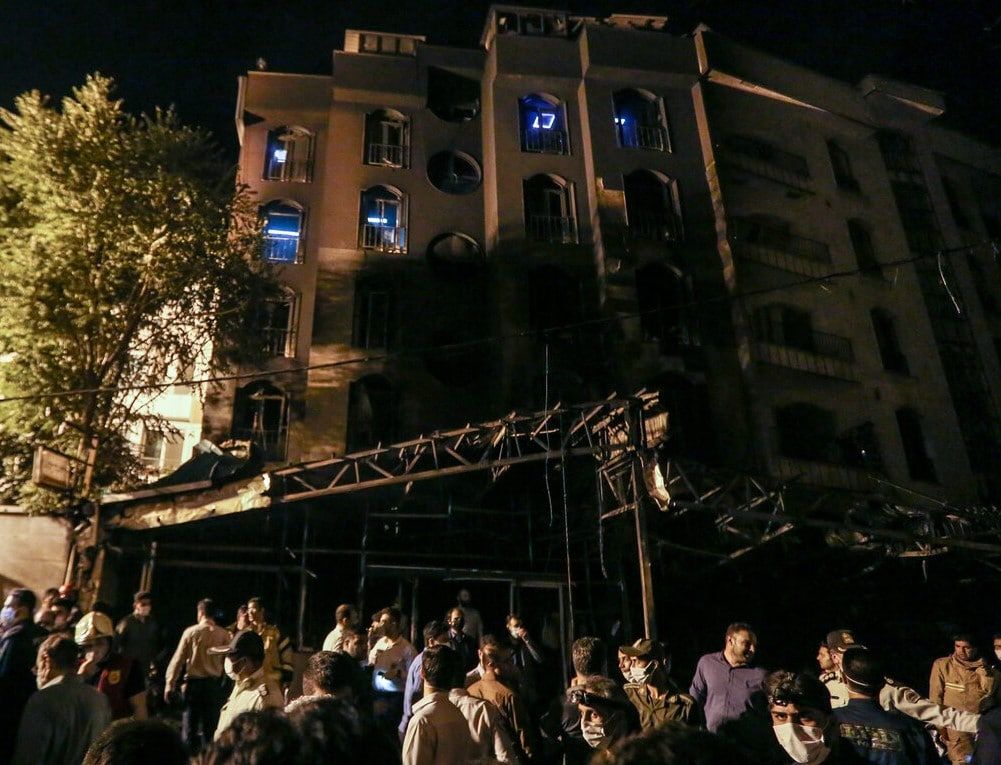Experts blame Israel for the recent explosions. Why won’t Iran?
By Farhad Rezaei | July 23, 2020
 An explosion at the Sina Athar clinic in Tehran on June 30 left 19 people dead. Image credit: Nazanin Kazemi Nava, IRNA.
An explosion at the Sina Athar clinic in Tehran on June 30 left 19 people dead. Image credit: Nazanin Kazemi Nava, IRNA.
Since late June, there have been dozens of fires and explosions at or near nuclear, military, and industrial facilities in Iran. Experts see the clear possibility of Israeli sabotage in many of these incidents and describe an attempt to disrupt Iran’s re-emerging nuclear program, but Iranian officials have refrained from pointing the finger. Is it plausible for Israel to be behind these serial explosions? And, if it is, why are the Iranians not responding? To answer these questions with any degree of accuracy, an examination of the timing and the locations of these explosions is crucial.
Khojir missile facility. The first episode took place on June 25, when a massive explosion struck an underground tunnel system of the Shahid Bakeri Industrial Group at the Khojir Missile Facility, located in eastern Tehran. As far back as 2010, an Iran expert at the Center for Strategic and International Studies had identified Khojir as a “site of numerous tunnels, some suspected of use for arms assembly,” although some of its other functions remain unknown. The facility is also close to the Parchin military complex, a more familiar name because of the reports of the International Atomic Energy Agency (IAEA), and a place that has been on the minds of US and Israeli intelligence services for over 20 years because they believe Iran conducted illicit nuclear activities there in the past, including tests of explosive triggers that could be used in atomic bombs.
Similarly, the missile program of Iran has long been a target of Mossad, Israel’s national intelligence agency. In November 2011, a massive explosion at the Bid Kaneh missile development site completely destroyed several buildings and killed General Hassan Tehrani Moghaddam, the father of Iran’s ballistic missile program, along with 38 others. The incident was widely viewed as an act of sabotage by Israel as a way to degrade the impressive strides in Iran’s missile program.
Furthermore, the missile industry of Iran’s Revolutionary Guards has been on the Mossad hit list as a result of its role in providing Hezbollah with advanced GPS components and precision-guided missiles capable of hitting anywhere in Israel. Countering Iran’s missile threat was a priority in Israel’s intelligence assessment for 2019, and Israeli Prime Minister Benjamin Netanyahu promised to take actions against it in Lebanon, Syria, Iraq, or even inside Iran itself. So it is plausible that Israel had a clear motivation to deal with this alleged source of threat.
But beyond that, evidence of Israeli sabotage is thin. Immediately following the incident, a spokesperson for Iran’s defense ministry said the explosion was inadvertent and involved industrial gas tanks. Although the explanations by Iranian officials did not quite add up, the possibility of an accident cannot be ruled out.
Sina Athar Health Center. On June 30, a few days after the missile facility incident, a blast at the Sina Athar Health Center caused significant damage to the building and surrounding area and killed 19 people. According to the Iranian government, this incident, too, was inadvertent, caused by a leak from medical gas tanks in the building.
Unlike at the missile facility, where Israel may have a motivation to carry out an act of sabotage, a medical clinic would not seem to be a target. However, if one were looking for an explanation, one possible—albeit remote—scenario is that the Iranians might have been hiding sensitive material related to their nuclear program in the clinic. After all, the Iranians are skillful in using a public facade for an illicit nuclear program. An enormous archive of documents stolen from Iran by Mossad agents in 2018 uncovered a facility where, according to Prime Minister Netanyahu, the Iranians concealed “massive amounts of equipment and material” related to a nuclear weapons program. When the IAEA tried to investigate, Iran claimed it had been a carpet cleaning factory. This tactic of hiding illicit activities in plain sight has successfully been used by the regime in the past, and it is plausible that the regime may use this tactic again.
Natanz. On July 2, hardly a day after the calamity at the health center, a massive explosion struck a house used for the assembly of the highly advanced centrifuges at Natanz nuclear facility, the heart of Iran’s nuclear program. Satellite images show that the explosion left a 10-meter crater and destroyed most of the building. Independent experts declared it “a major setback to Iran’s abilities to deploy advanced centrifuges on a mass scale for years to come.”
What caused the blast? The possibilities initially included a planted bomb, a cruise missile, a cyberattack, or a simple accident, although the New York Times reported that Iranian investigators quickly settled on the first possibility as the most likely.
The explosion at Natanz is particularly concerning because it was the place where advanced centrifuge models were assembled to be deployed to enrich uranium. The workshop, which first became operational shortly after President Trump had announced that the United States was withdrawing from the Iran nuclear deal in 2018, would enable Iran to enrich uranium faster and at higher level than had been possible.
Natanz has been the subject of numerous US-Israeli cyberattacks in the past. In 2006, then-director of Mossad Meir Dagan and US Maj. Gen. John Cartwright both concluded that Israel and the United States needed to use cyberwar to slow down or destroy Iran’s nuclear program. Thereafter, the two countries secretly unleashed a wave of computer malwares against Iran’s nuclear program as part of the Operation Olympic Games, first uncovered in 2010. Even two years after an element of the program became public, President Obama sped up cyberattacks against Natanz. According to one estimate, the malware destroyed up to 1,000 centrifuges and inflicted a significant psychological havoc on the Iranians, leaving them puzzled and disoriented.
News reporting following the explosion at Natanz has bolstered the case for Israeli involvement. The New York Times cited an unnamed Middle Eastern intelligence official who laid the blame squarely with Israel. Israeli officials, as is their custom, have been strategically vague about their country’s involvement. Defense Minister Benny Gantz said after the incident, “Not every event that happens in Iran is necessarily related to us.” Shortly after that, the Israeli foreign minister pointed to Israel’s longtime policy not to let Iran acquire a nuclear capability and said, “we take actions that are better left unsaid.”
The mysterious incidents at industrial and military sites continue. On July 9, Iranian social media users reported that four explosions were heard at the Imam Hassan Mojtaba garrison and the Islam Aerospace Garrison in Garmdareh, Alborz province. Official Iranian news outlets attempted to manipulate reports about the explosion by uploading a video of the mayor of Garmdareh, who claimed there had been an accident at a gas cylinder facility. However, social media activists and bloggers refuted the authenticity of the video, saying that the quoted official, Houman Ghodsi, died last year. Moreover, the Fars News Agency, a news outlet belonging to the Revolutionary Guards, interviewed residents from nearby towns who claimed that nothing happened.
On July 13, a fire broke out at the Kavian Fariman industrial complex in Mashhad, in northeast Iran, where gas condensate storage tanks are supposedly located. According to the fire chief at the facility, six storage tanks had caught fire and one exploded. Several fires were also reported at Shian Forest Park in eastern Tehran and at the Shahid Motahari bazaar in Najafabad, Isfahan. On July 15, Tasnim News, another outlet close to Iran’s Revolutionary Guards, reported that fires had broken out at a shipyard in Bushehr in southern Iran, damaging at least seven ships, as well as at the Lamard Aluminum Complex in Fars province.
Iranian retaliation? In all of these incidents, Iranian officials have tried to downplay the impact and reject possible Israeli involvement. For instance, Abbas Mousavi, the spokesman for Iran’s ministry of foreign affairs, told reporters after the Natanz explosion that whatever happens around the world, Israel may take responsibility, but that it was still too early to make any judgment regarding the main cause for the blast. According to Mousavi, those who attribute these blasts to Israel are effectively pursuing the goal of portraying it as a powerful state. Similarly, Mohammad Ismail Kowsari, former operational commander of the Revolutionary Guards’ Sarollah base in Tehran, noted that, “It is possible that the Zionist regime wants to be perceived as the one who carried out the explosion at the [Natanz] nuclear site … but this is nothing more than propaganda.”
Such attempts to deny Israeli involvement sound strange when, in the past, Iranian officials have blamed Israel for almost everything that has happened in the country, ranging from climate change and natural disasters like drought, floods, and earthquakes to poverty, economic crises, and domestic corruption.
So why would Iranians downplay the extent of the events and deny Israeli involvement? There are a few plausible explanations. First is to avoid embarrassment. The explicit admission of sabotage, coupled with Iran’s inability to stop it, would make the regime and its security institutions look completely powerless, incompetent, and fragile in the eyes of the Iranian people.
Second is to avoid falling into a trap. Iranians believe that these explosions represent a paradigm shift in how the US-Israeli political and security establishments deal with Iran. According to the Iranians, the United States and Israel are working very hard to provoke Iran into retaliation, either in terms of a kinetic attack or in terms of ramping up its nuclear program. The latter outcome would give them more grounds to declare Iran noncompliant with IAEA safeguards and eventually return international sanctions via the UN Security Council. Because retaliation would risk uncontrolled escalation and could result in a full-scale war with Israel and the United States—an outcome Iran wants to avoid—officials may be taking ample precaution.
Relatedly, Iranians believe time is on their side. They think that President Trump will likely lose the upcoming election, and if Joe Biden, the Democratic candidate, gets elected, he will return to the nuclear agreement and lift sanctions on Iran accordingly. So the Iranians may be hesitant to do anything that would upset this state of affairs.
The bottom line, given the silence of Iranians, is that it is highly likely that there will be more incidents at sensitive military and nuclear sites, and Iran seems to be unable to do anything to stop them.
Together, we make the world safer.
The Bulletin elevates expert voices above the noise. But as an independent nonprofit organization, our operations depend on the support of readers like you. Help us continue to deliver quality journalism that holds leaders accountable. Your support of our work at any level is important. In return, we promise our coverage will be understandable, influential, vigilant, solution-oriented, and fair-minded. Together we can make a difference.
Keywords: Iran, Iranian Revolutionary Guard Corps, Iranian nuclear program, Israel, sabotage
Topics: Nuclear Risk















